Now Then. Velveteen.

figure eight scarf
I (possibly like you) have been counting the moments for all of my velveteen fabrics to arrive. And just like introducing the voiles through a little write-up earlier this year where I professed my love and offered my experiences with them, I thought it would be nice to welcome the velveteens in a similar way. Just like the voiles, I think that once you have the chance to touch these velveteens, that no one would really have to warm you up to the idea of bringing a little bit home. But in case you have questions, I thought I would jump ahead with some answers.
Velveteen
Velveteen has in some instances been thought of as a substitute of sorts for velvet, or even a lower priced imitation of velvet. In their most typical formats, there is an inherent difference between the two fabrics. Velvet, traditionally, was woven as two cloths weaving at the same time, continually connected by threads that would then be cut to separate the two cloths from each other, leaving those cut threads as the high piled, textured surface that we are all familiar with. Velveteen's pile is rather made by floating in filler threads throughout the base weaving process, and typically the pile is shorter. There are additional, more advanced processes to create both of these substrates now, but in general they both have a "pile" which give both velvet and velveteen their luxurious feel. Any fiber can be made into velvet or velveteen, but silk and cotton are the most common fibers used. Silk being found more often in velvet and cotton more often in velveteen.
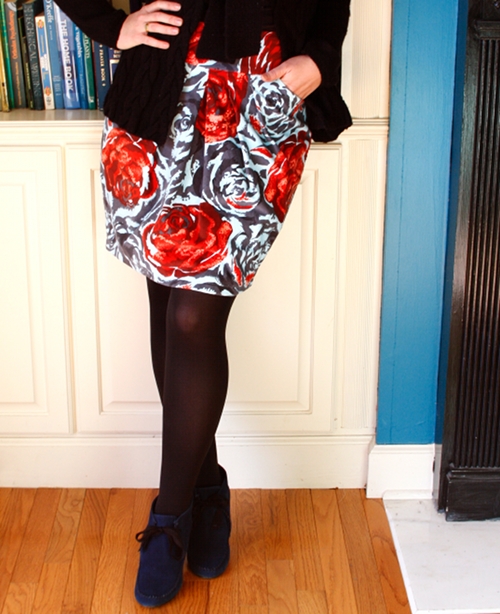
proper attire skirt, option a
My Velveteen
The 100% cotton velveteen that I settled on, in particular, was chosen because the cloth is just so supple, fluid and the pile is not so high that I thought it would interfere with what I am used to in the printing process. The weight is also one that is perfect for just about everything you might use a home decor cotton for, but with the additional luxury of softness and depth of color. In short, it is fancy and snuggly all at once. So bring on the projects: coats, skirts, jackets, baby pants, soft toys, handbags, quilts, little girl jumpers, pillows, coverlets, scarves....on and on!
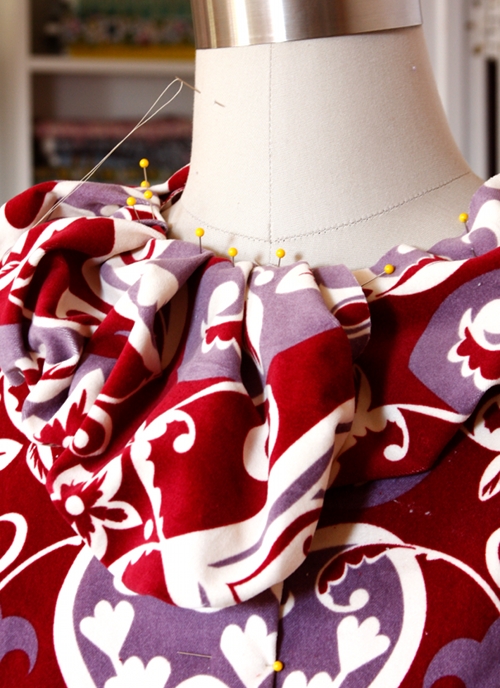
my winter coat in the making
Cutting
Once I committed to my first project with the velveteen (my Proper Attire Skirt) obviously the first thing that I encountered was the cutting. I was for some reason more inclined to use my scissors than the rotary cutter. There is no real basis for this, but I felt like I wanted a little more control as I went through a thicker fabric. However cutting through two layers at a time for pieces on a fold, or same pieces right sides together, has been easy with both the scissors or the rotary. I would not recommend cutting more than two layers at once, though, because when right sides of the velveteen are together those little fibers act like caterpillar legs and they tend to want to "walk" across each other. So a little position shift can happen that you likely won't appreciate.

multi-tasker tote
Sewing, Needles, Thread, Pinning
One thing I definitely noticed as I sewed was the "snowing" that these velveteens do as you go. In one way the velveteen substrate is feels tightly woven because those "floating" filler fibers are packed in rather snugly. However, once cut, those fibers at the edge come a bit loose and the more you handle the pieces the more loosely woven the edges begin to feel. This really has not been so extreme that I even think about it anymore, just an impression and therefore warning for you. I love snowing. Snowing is my favorite. Zig-zagging or serging edges can definitely help out with this.
I haven't found that the machine thread or needle requirements are really any different than what I would use for a home decor weight cotton. So either 100% cotton, or dual-duty thread, and a sharp tip needle around size 11 or 14 is perfectly suitable. If you sew several velveteen items, you might find you need to clean the fuzz outta your machine a little more often, but in general the sewing isn't too different. But just as with the "walking" legs of the fibers that can happen with several layers being cut at once, this can occur a little as you sew. The velveteen may have a tendency to creep away leaving your aligned edges a little off if you don't stay ahead of it with your hands, or pin. In fact if you're not a pinner (always depends on the project for me) you might want to become one.
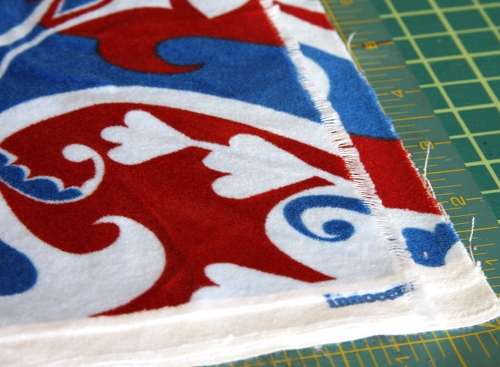
Washing, Drying, Ironing
Another thing that I really appreciate about this fabric is how easy it is to care for. Being 100% cotton, it is machine washable and comes out beautifully with perfect color retention, even after a few washings. For a sampling, (see above photo) I washed a fat quarter (18x27") on a cold wash/cold rinse short/gentle cycle with a mild detergent. There is a little more fraying than the standard quilting cotton (a lot more compared to the voile which has almost none) that is noticeable even after just being pulled out of the wash. I dried in the dryer on a medium heat setting and low spin. The shrinkage on the width of the fabric was zero. The shrinkage on the length of the fat quarter was about 1/2"- but the added depth of additional fraying on the length edges causes about an additional 1/2" loss of usable fabric. Therefore, you can expect the total loss of length to be about 1" per half yard or 2" per yard of length. Good to keep in mind when purchasing yardage. I know that my patterns allow about 4" length extra when calling out yardage, as I believe most other patterns do. Dry cleaning is also probably okay too, but as with all cottons, you would want those dry cleaning treatments to be as few as possible.
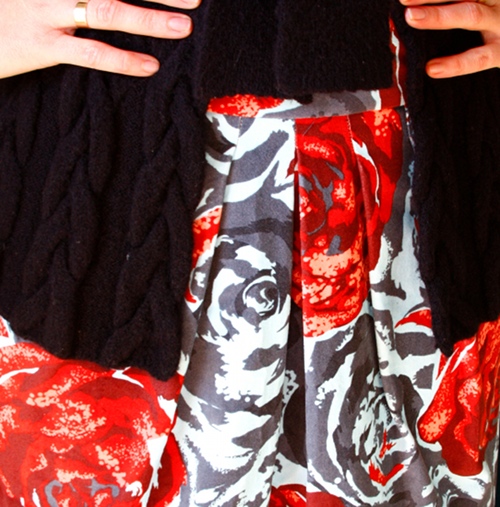
Some of you might be familiar with a needle board which looks and feels exactly like you might think. It is a small, hard board with thousands of tiny little packed in needles poking up. Most velvets would require that you place the velvet pile (right) side down onto the needleboard, allowing the pile fibers to settle into and between the needles before pressing it on the wrong side. This prevents the iron and heat from crushing the pile thus distorting the surface of the fabric, which can be hard to undo. Good news. I really, really don't think you need a needleboard to press these velveteens. Pressing them on the wrong side at a medium-high heat for me has produced wonderful results with no change in the look of the right side surface. Pressing them lightly with steam from the right side even works out well. I would mention that if you press really, really firmly at seams on the right side, than you will sorta force the fibers to turn down a bit, exposing the inner white of the base of the cloth just a little. So I would just lay another scrap piece of velveteen right side against the piece to be ironed and use that as a pressing cloth if you need to do some firm ironing. This will allow their fibers to settle into one another, and improve your results.
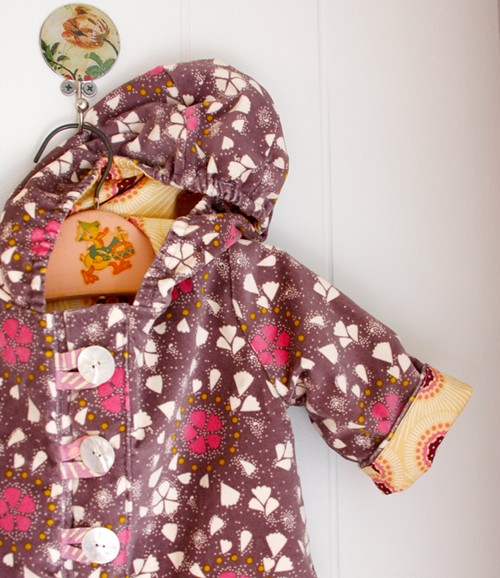
baby-in-the-hood jacket from handmade beginnings
Quilting, Lining, Durability
When combining the velveteens with other fabrics, I have had great results. Yes, I have included them in quilts and I love it! It is definitely a bit bulkier than what you would be used to with a regular quilting cotton, but what soft luxury. The next item on my personal to-do list is a patchwork throw with a mix of all sorts of fabrics, but mostly velveteens. The weight of the goods provides a lot of warmth (but not suffocation) so that I plan to completely forego the batting layer, and just have a lovely patchwork coverlet. This is a similar concept to the little swaddling blankets that we do with voile and flannel, but I plan to make a full size one with hand tacking. I will let you know how it goes! (We have actually had a store-bought velvet quilt which does have batting on our bed for years that I love, but man, it is warm!)
A tip about garments, particularly skirts that you'll likely be wearing in the winter: line them with something slinky, and not a woven cotton. China-silk or similar is perfect. You will likely be wearing tights very often, and you don't want the woven cotton "grabbing" onto your tights as you walk. Also the wrong side of the velveteen needs to be able to fall away as well, and not get hung up on the lining. So even though I would love to encourage you to use my voile solids, instead save those for floaty lining items, garments made from the voile.
Without the benefit of lots of time to test, I would say that this fabric will be durable, but items that are used repeatedly and get a constant source of wear on one spot or another will show such, by the inner white of the velveteen eventually showing as the cushy fibers wear with use. But that never stopped anyone from loving the Velveteen Rabbit, now did it?
Cost
The suggested retail for these goods is $22.00 per yard, but thankfully they are wider at 55", and I think compared to like fabrics in the market place are a very good value. Not just that, but you can use them in sparing ways to make a big beautiful impact.
So do that, and I hope you love them as much as I do!
xoxo, Anna



Comments